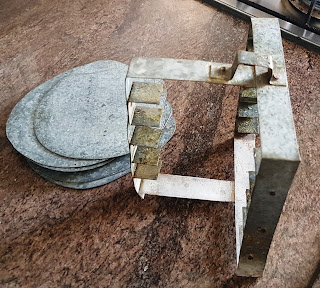-by Aishwarya Pramod and Janaki Krishnan
Like all Palakkad Iyers, I love kanatha vadam. But whenever I think of it, it's always with a twinge of guilt. Not because kanatha vadam is unhealthy. Rather, it is because the dish takes a humongous effort to make, but almost no time to finish off. All that work for only a moment of deliciousness? So self-indulgent. :P
Non-Palakkad-Iyers might ask, what are kanatha vadams? At the risk of sounding clinical, they are steamed rice flat-cakes that are sundried to make papads :). During the papad-making process, a few of them are set aside for immediate eating (without drying).
My grandmother has loved kanatha vadam since she was a young girl. She penned down the recipe and her memories associated with it. Here is what she wrote.
 |
| Writing down the recipe |
xxxxxxxxxxxxxxxxxxxxxxxxxxxxxxxxxxxxxxxxxxxxxxxxxx
Kanatha Vadam by Janaki Krishnan
I learnt to make kanatha vadam at a schoolgoing age. Kanatha vadam means "thick vadam". It's made on a set of leaf-shaped metal trays. It's also called elai vadam, meaning "leaf vadam".
 |
| The "leaves" for making kanatha vadam |
Ingredients
- 1 glass puzhungal arisi. This is parboiled unpolished rice. It is slightly reddish because a bit of the husk remains on the grain. We use this rice to make idli too
- 1 glass polished rice
- Salt, chilli powder, hing (asafoetida) powder
- Metal leaves to cook the vadams. Right from my mother's time we have been using metal leaves, though traditionally, leaves are used. These leaves are available in the market or with flower sellers.
Once the paste is ready, add more water to it till it becomes the consistency of dosai batter. This will make it easy to spread on the leaf. Add a spoonful of sesame seeds (optional).
 |
| The rice paste with sesame seeds |
 |
| Spreading the paste on the leaves |
 |
| Steam for 2 minutes |
 |
| Ready to eat |
I still love kanatha vadam. I prefer eating them directly rather than drying and deep-frying. The steamed ones have very little oil and I can easily eat half a dozen.
Aishwarya back again :)
Like my grandma, my mom has also been a long time fan of kanatha vadam. I myself wasn't a big fan, until I was suddenly converted a few years ago. I'm back home after finishing my MBA. It turns out that Amma has developed a slight addiction and asks Shyamala (her cook) to make these vadams every fortnight or so.













































